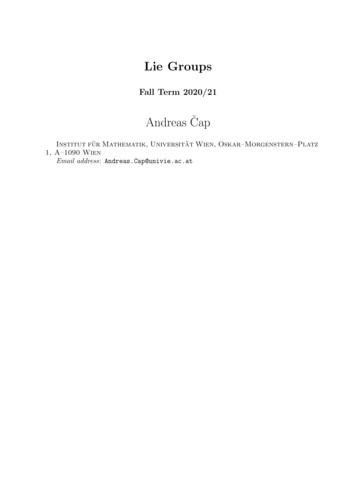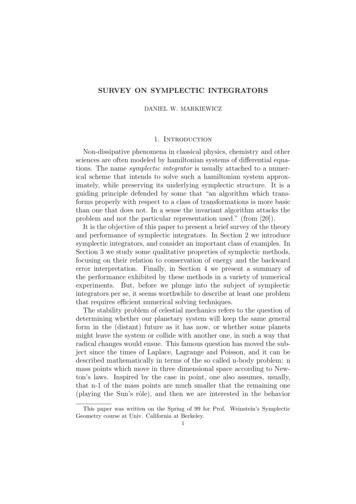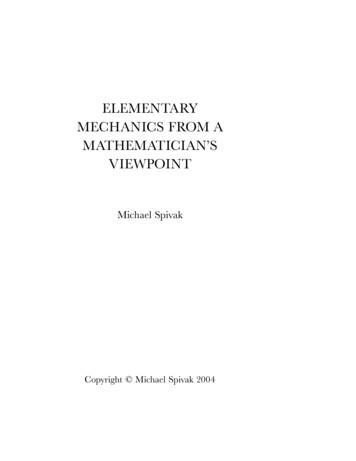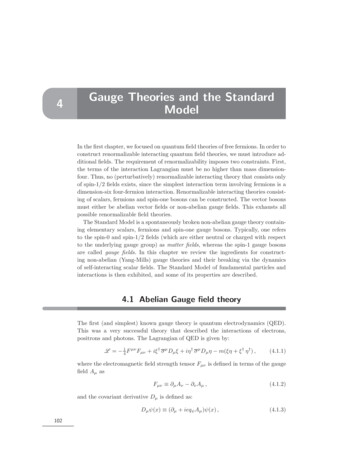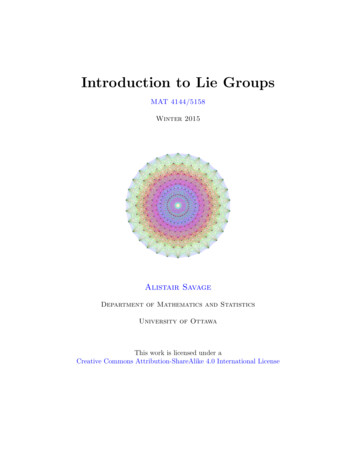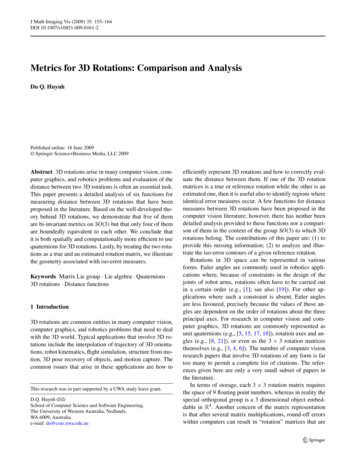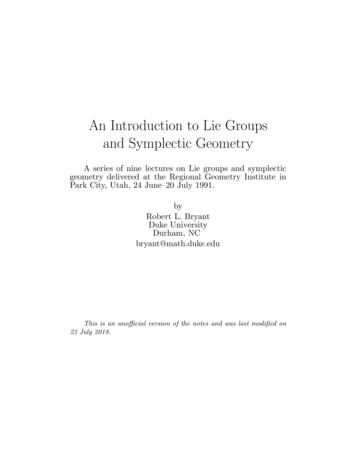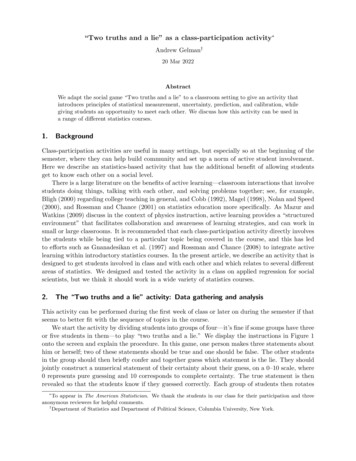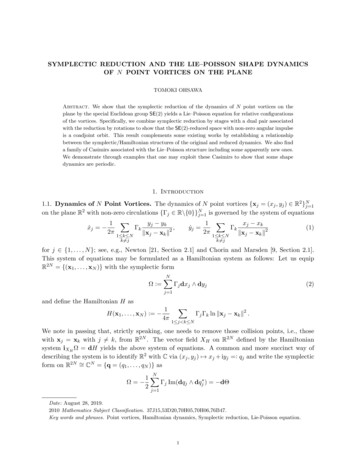
Transcription
SYMPLECTIC REDUCTION AND THE LIE–POISSON SHAPE DYNAMICSOF N POINT VORTICES ON THE PLANETOMOKI OHSAWAAbstract. We show that the symplectic reduction of the dynamics of N point vortices on theplane by the special Euclidean group SE(2) yields a Lie–Poisson equation for relative configurationsof the vortices. Specifically, we combine symplectic reduction by stages with a dual pair associatedwith the reduction by rotations to show that the SE(2)-reduced space with non-zero angular impulseis a coadjoint orbit. This result complements some existing works by establishing a relationshipbetween the symplectic/Hamiltonian structures of the original and reduced dynamics. We also finda family of Casimirs associated with the Lie–Poisson structure including some apparently new ones.We demonstrate through examples that one may exploit these Casimirs to show that some shapedynamics are periodic.1. Introduction1.1. Dynamics of N Point Vortices. The dynamics of N point vortices {xj (xj , yj ) R2 }Nj 1on the plane R2 with non-zero circulations {Γj R\{0}}Nj 1 is governed by the system of equationsyj ykxj xk1 X1 Xẋj ΓkΓk,ẏ (1)j22π2πkxj xk kkxj xk k21 k N1 k Nk6 jk6 jfor j {1, . . . , N }; see, e.g., Newton [21, Section 2.1] and Chorin and Marsden [9, Section 2.1].This system of equations may be formulated as a Hamiltonian system as follows: Let us equipR2N {(x1 , . . . , xN )} with the symplectic formΩ : NXΓj dxj dyj(2)j 1and define the Hamiltonian H asH(x1 , . . . , xN ) : 14πXΓj Γk ln kxj xk k2 .1 j k NWe note in passing that, strictly speaking, one needs to remove those collision points, i.e., thosewith xj xk with j 6 k, from R2N . The vector field XH on R2N defined by the Hamiltoniansystem iXH Ω dH yields the above system of equations. A common and more succinct way ofdescribing the system is to identify R2 with C via (xj , yj ) 7 xj iyj : qj and write the symplecticform on R2N CN {q (q1 , . . . , qN )} asNΩ 1XΓj Im(dqj dqj ) dΘ2j 1Date: August 28, 2019.2010 Mathematics Subject Classification. 37J15,53D20,70H05,70H06,76B47.Key words and phrases. Point vortices, Hamiltonian dynamics, Symplectic reduction, Lie-Poisson equation.1
2TOMOKI OHSAWAwithNΘ : 1XΓj Im(qj dqj ),2j 1and the Hamiltonian asH(q1 , . . . , qN ) 14πXΓj Γk ln qj qk 2 .(3)1 j k NThen the system is written asq̇j qj qki XΓk2π qj qk 2(4)1 k Nk6 jfor j {1, . . . , N }.This system has SE(2) SO(2) n R2 -symmetry under the actionSE(2) CN CN ;((eiθ , a), q) 7 eiθ q a1,(5)where we identified R2 with C and defined 1 : (1, . . . , 1) CN .It is well known (see, e.g., Newton [21, Equation (2.1.5) on p. 69]) that one may derive a set ofequations for the inter-vortex distances lij : qi qj of the point vortices; they are often referredto as the equations of relative motion or the shape dynamics; see (6) below. From the geometricpoint of view, this corresponds to the reduction of the dynamics by the above SE(2)-symmetry:This symmetry is essentially due to the uniformity of the ambient space, and hence “dividing”the dynamics by this symmetry results in the shape dynamics. Such a reduction by symmetry—called symplectic or Hamiltonian reduction—is one of the main topics of the geometric approachto Hamiltonian dynamics; see, e.g., Abraham and Marsden [1], Marsden and Ratiu [16], Marsdenet al. [18], and references therein. The use of shape space/dynamics is particularly popular inthe N -body problem of classical mechanics; see, e.g., Iwai [14], Montgomery [20], and referencestherein.1.2. Motivating Examples. We would like to show some motivating examples before discussingthe main result of the paper. The first example is the case with N 3 and Γ1 Γ2 Γ3 6 0. Usingthe inter-vortex distance lij : qi qj between the vortices i and j and the signed area11 x1 x3 x2 x3A : Im((q1 q3 )(q2 q3 ) .22 y1 x 3 y2 x 3of the triangle formed by the point vortices, we can derive, using (4), the equations of relativemotion mentioned above (see Newton [21, Equation (2.1.5) on p. 69], Aref [3, Eqs. (22) and (25)],and also references therein):!2Γi 11d 2l A for (i, j, k) Z3 ,2 l2dt jkπ lkiij(6)2 l2Xlki1ijȦ (Γj Γk ) 2,8πljk(i,j,k) Z3where Z3 : {(1, 2, 3), (2, 3, 1), (3, 1, 2)}. These equations govern the shape dynamics of the pointvortices.We will reformulate this set of equations as a Lie–Poisson equation on the dual of a certain Liealgebra, just as in Borisov and Pavlov [8] and Bolsinov et al. [7] as a result of the SE(2)-reduction.
SHAPE DYNAMICS OF N POINT VORTICES ON THE PLANE3Figure 1. Numerical solution of (1) with N 3 and (8). The black triangle is the shapeformed by the initial positions of the point vortices. Blue is the trajectory of the first vortex,orange the second, and green the third. The trajectories are not exactly periodic.The Lie–Poisson formulation helps us find a family of Casimirs (conserved quantities) including thefollowing apparently new one:!42 l2 l2 )2Xljk(lijΓ1 Γ2 Γ3 2kijkC2 8 A .(7)22Γj ΓkΓ1 Γ2 Γ3Γi(i,j,k) Z3Figure 1 shows a numerical solution of (1) along with the triangle connecting the initial positionsof the three vortices with 5(8)(q1 (0), q2 (0), q3 (0)) 1 2i, 2 4i, 2i , (Γ1 , Γ2 , Γ3 ) (5, 10, 15).3PThis initial condition satisfies 3j 1 Γj qj (0) 0, which is a conserved quantity called linear impulseof the system as we shall see below in (10). Figure 2 shows snapshots of the same solution along withthe triangle connecting the positions of the point vortices. The triangle seems to change its shapeperiodically. We will show in Section 4.1 that the shape dynamics is indeed periodic exploiting theCasimir (7). Note however that the trajectories of the vortices are actually not periodic: Thesetrajectories shown in Fig. 1 do not exactly come back to the initial positions.The other motivating example is the case with N 4 and 5(q1 (0), q2 (0), q3 (0), q4 (0)) 1 2i, 2 4i, 5, (5 i) , (Γ1 , Γ2 , Γ3 , Γ4 ) (5, 10, 7, 8) (9)8PPso that that 4j 1 Γj 0 as well as 4j 1 Γj qj (0) 0. Figure 3 shows a numerical solution of(1) along with snapshots of the quadrangle connecting the positions of the point vortices. Thetwo neighboring quadrangles slightly left from the center at the bottom are the initial and terminalones. Note that the terminal quadrangle appears to be congruent to the initial shape, but is locatedat a slightly different position, again indicating that the shape dynamics may be periodic but thetrajectories of the vortices are not.
4TOMOKI OHSAWAFigure 2. Snapshots of numerical solution from Fig. 1 with the triangle connecting the pointvortices. The triangles in each column seem to be congruent, suggesting that the trianglechanges its shape periodically.Figure 3. Numerical solution of (1) with N 4 and (9). Blue is the trajectory of the firstvortex, orange the second, green the third, and violet the fourth. It also shows snapshotsof the quadrangle connecting the vortices in the numerical order; the shape dynamics againseems periodic.
SHAPE DYNAMICS OF N POINT VORTICES ON THE PLANE51.3. Main Results. We perform SE(2)-reduction of the Hamiltonian dynamics of N point vorticeswith non-zero angular impulse and show that the resulting dynamics can be written as a Lie–Poissonequation in a coadjoint orbit. The main goal of this paper is to show that the SE(2)-reductionnaturally gives rise to the Lie–Poisson equation.That one can write the reduced/shape dynamics of N point vortices as a Lie–Poisson equationis not new. Borisov and Pavlov [8] found the Lie–Poisson bracket for the reduced dynamics ina rather direct manner, and Bolsinov et al. [7] gave a Lie-algebraic interpretation of the resultby defining a so-called vortex algebra, and showed that it is isomorphic to the indefinite unitaryalgebra u(n1 , n2 ) for some n1 , n2 {0, . . . , N 1} such that n1 n2 N 1, depending on the signsof the circulations {Γj }Nj 1 . More recently, Hernández-Garduño [12] (see also Hernández-Garduñoand Shashikanth [13]) showed that the reduced dynamics of three point vortices may be writtenas a Lie–Poisson equation on u(2) with the standard Lie–Poisson bracket by constructing a set ofcovectors satisfying the Pauli commutation relations.The main contributions of this paper are the following: (i) We identify the Lie–Poisson structure as the natural symplectic structure on the reduced space by performing symplectic reduction bythe SE(2)-symmetry, thereby establishing a clear connection between the original symplectic structure (2) with the Lie–Poisson structure (Theorem 3.4). The resulting Lie–Poisson equation yieldsthe equations (6) of relative motion. (ii) The Lie–Poisson structure naturally gives rise to Casimirsthat may provide additional conserved quantities (Corollary 3.6). Some of the Casimirs are apparently new, while others are well-known conserved quantities. We exploit these Casimirs to showthat the shape dynamics from the above examples are in fact periodic.1.4. Outline. Particularly, we perform the SE(2)-reduction by stages by first performing the reduction by R2 (see Section 2), and then by SO(2) (see Section 3). We note that Bolsinov et al.[7] seem to work the other way around, i.e., first by rotations and then by translations, althoughit is not particularly clear how one can perform the R2 -reduction of the SO(2)-reduced space, norhow the symplectic structures are related to each other. We stick to the former approach becausethat is the procedure justified by the semidirect product reduction (see, e.g., Marsden et al. [18,Theorem 4.2.2 on p. 122]).Our work elucidates how the original symplectic structure Ω gives rise to a symplectic structureΩZ or ΩZ0 (Propositions 2.4 and 2.6) on the R2 -reduced space, and also in turn, ΩZ or ΩZ0 givesrise to the Lie–Poisson structure as a result of the SO(2)-reduction if the angular impulse is nonzero (Theorem 3.4). As we shall see in Section 2, the two symplectic structures ΩZ and ΩZ0 on thePR2 -reduced space correspond to those cases where the total circulation Γ : Nj 1 Γj is non-zeroand zero, respectively. These two cases result in slightly different geometries and hence requireseparate treatments. Nevertheless, the resulting symplectic structures ΩZ and ΩZ0 have similarstructures, and hence the SO(2)-reduction to follow works the same way.As an aside, we note that the initial inspiration came from the work of Montgomery [20] onthe reduction of the three-body problem (of celestial mechanics not of point vortices). The mapΦ defined in (25) (or π rot defined in (31)) in [20] used for reduction by rotational symmetry isa momentum map if one thinks of the configuration space R2 C—not its cotangent bundle—as a symplectic vector space in the standard manner. While this symplectic structure on theconfiguration space has little significance in celestial mechanics, it is an essential ingredient inpoint vortex dynamics as its Hamiltonian formulation employs a variant (2) of this symplectic
6TOMOKI OHSAWAstructure. The corresponding momentum map in our context constitutes one leg of the dual pairwe will exploit in this paper; see Section 3.3.2. Reduction by Translational SymmetryThe first stage of the SE(2)-reduction by stages is the reduction by the translational symmetry. Asmentioned above, we need slightly different treatments depending on whether the total circulationPΓ : Nj 1 Γj is zero or not.2.1. Translational Symmetry and Momentum Map. Consider the translational part of theSE(2)-action (5), i.e., C R2 -action on CN as follows:C CN CN ;(a, q : (q1 , . . . , qN )) 7 q a1.The corresponding infinitesimal generator for α C is then written as!NX αCN (q) α α , qj qjj 1Then one sees thatiαCN Ω dI αwithNiXΓj (α qj αqj )I (q) : 2j 1 NNXX1 iΓj qj α α iΓj qj 2j 1j 1* NX, iΓj qj , ααj 1Cwhere we defined an inner product on C as hα, βiC : Re(α β). Hence we have I α (q) hI(q), αiwith the momentum map I : CN C C defined byI(q) : iNXΓj qj .(10)j 1This is essentially the so-called linear impulse; see, e.g., Newton [21, Section 2.1] and Aref [3]. ByNoether’s Theorem (see, e.g., Marsden and Ratiu [16, Theorem 11.4.1]), this is a conserved quantityof the system (4).The above momentum map is not equivariant except for a special case:Lemma 2.1. The momentum map I is equivariant if and only if the total circulationΓ : NXj 1vanishes.Γj
SHAPE DYNAMICS OF N POINT VORTICES ON THE PLANE7Proof. Since C is abelian, the coadjoint action is trivial; hence equivariance would be I(q a1) I(q) for any a C. However, it is straightforward to see that, for any a C,I(q a1) I(q) iΓa. 2.2. Reduction by Translational Symmetry. Let c C be arbitrary and consider the level set N X 1NI ( ic) (q1 , . . . , qN ) C (11)Γj qj c , j 1which defines an affine subspace of CN . It has different symplectic-geometric properties dependingon the value of the total circulation Γ:Lemma 2.2. The affine subspace I 1 ( ic) CN is symplectic if Γ 6 0 whereas it is coisotropic ifΓ 0.Proof. Let us write A : I 1 ( ic) for short and find the symplectic orthogonal complement (T A)Ωof the tangent space T A of A. Let q A be arbitrary and v (v1 , . . . , vN ) CN be an arbitraryelement in Tq A by identifying Tq A with a subspace of CN in a natural manner for notationalP 1Nsimplicity. Then we have ΓN vN Nj 1 Γj vj . For an arbitrary w (w1 , . . . , wN ) Tq C , wehaveΩ(v, w) NXΓjj 1 NX2Im vj wj vj wjΓj Im vj wj j 1 N 1X Im Γj vj (wj wN ) .j 1Since v1 , . . . , vN 1 C are arbitrary, it follows that (Tq A)Ω w CN w1 · · · wN C1,where we defined C1 : a1 CN a C .Hence we see thatΩ Tq A (Tq A) a1 CN a C, aΓ 0 ({0}C1 (Tq A)ΩΓ 6 0,Γ 0.Therefore, if Γ 6 0 then A is symplectic, whereas if Γ 0 then (Tq A)Ω Tq A for any q A, andso A is coisotropic. As a result, we obtain the reduced space as follows:Proposition 2.3 (Reduction by translational symmetry).(i) If Γ 6 0, the reduced space by the translational symmetry is I 1 ( ic) itself for any c C; theaffine subspace I 1 ( ic) in turn may be identified with the subspace I 1 (0) CN 1 .(ii) If Γ 0, the reduced space is I 1 ( ic)/C and may be identified with I 1 (0)/C CN 2 .
8TOMOKI OHSAWAProof. Suppose first that Γ 6 0. By Lemma 2.1, the momentum map I is not equivariant. Therefore,we would like to invoke the non-equivariant symplectic reduction (see, e.g., [18, p. 17]). Based onwhat we observed in the proof of Lemma 2.1, we define a cocycle σ : C C C asσ(a) : I(q a1) I(q) iΓa.This gives rise to the new action Ξ : C C C defined byΞ(a, ic) : ic σ(a) i(c Γa).The isotropy group of this action is clearly trivial, i.e., C ic {0}. Hence the (non-equivariant)Marsden–Weinstein quotient is I 1 ( ic) itself. However, one may shift the origin of CN so thatthe affine space I 1 ( ic) becomes the subspace I 1 (0) CN 1 . Note that this does not affect thedynamics because of the translational symmetry of the Hamiltonian (3).Now suppose that Γ 0. Then, by Lemma 2.1, the momentum map I is equivariant. Since C isabelian, the isotropy group is given by C ic C. Hence we obtain the Marsden–Weinstein quotientI 1 ( ic)/C. One sees from (11) that I 1 ( ic) defines an affine space of (complex) codimension one.Since C acts on it by translations in the direction of 1 inside I 1 ( ic), one sees that the quotientI 1 ( ic) is an affine space of (complex) codimension two, i.e., I 1 ( ic)/C CN 2 . Alternatively,for the same reason as above, one may identify I 1 ( ic) with the subspace I 1 (0). Then it is easyto see that I 1 (0)/C is a quotient of a vector space I 1 (0) CN 1 by its subspace C1 and hence isN 2isomorphic to C. This is nothing but the linear symplectic reduction of a coisotropic subspace;see, e.g., McDuff and Salamon [19, Lemma 2.1.7]. 2.3. Symplectic Forms on R2 -Reduced Space. Let us first consider the case with Γ 6 0. Theabove proposition tells us that the reduced space by translational symmetry may be identified withthe subspace N XI 1 (0) (q1 , . . . , qN ) CN Γj qj 0 . j 1We parametrize this subspace using the relative positions of the first N 1 point vortices withrespect to the last one, i.e.,z (z1 , . . . , zN 1 ) : (q1 qN , . . . , qN 1 qN ) CN 1 .(12)Then, N 1 X1Γj zjI 1 (0) (z1 , . . . , zN 1 , 0) qN 1 CN qN Γj 1 {(z1 , . . . , zN 1 ) CN 1 } CN 1 .We remove the those points for N -tuple collisions q1 · · · qN or equivalently z 0 to defineZ : I 1 (0)\{N -tuple collisions} CN 1 \{0}.Let us find the symplectic form ΩZ induced on Z by Ω.Proposition 2.4. If Γ 6 0, then the symplectic form on the R2 -reduced space Z can be written asΩZ dΘZ ,
SHAPE DYNAMICS OF N POINT VORTICES ON THE PLANE9where ΘZ is the one-form on Z CN 1 \{0} defined asΘZ : 1Im(z Kdz)2with Γ1 (Γ Γ1 )Γ1 Γ2. Γ2 Γ1 Γ2 (Γ Γ2 ) . . .1 K : .Γ .ΓN 1 Γ1ΓN 1 Γ2. Proof. The constraintNXPNj 1 Γj qjΓ1 ΓN 1Γ2 ΓN 1. . (13) ΓN 1 (Γ ΓN 1 ) 0 for q to be in Z I 1 (0) is rewritten in terms of z asΓj qj 0 j 1N 1XΓj zj ΓqN 0 qN j 1N 11 XΓj zj ,Γj 1and thus we may write the embedding ι : Z , CN asι : (z1 , . . . , zN 1 ) 7 (z1 qN , . . . , zN 1 qN , qN ).Then, straightforward calculations yield the pull-backΘZ : ι Θ N 1 X1 Γj (Γ Γj ) Im(zj dzj ) 2Γ j 1 X1 j,k N 1j6 k Γj Γk Im(zj dzk ) 1Im(z Kdz).2Hence the symplectic form on Z is given byΩZ ι Ω d(ι Θ) dΘZ . Remark 2.5. The matrix K is invertible under our assumption that Γj 6 0 for j {1, . . . , N }; seeLemma B.1.What if Γ 0? In this case, we may write the embedding i0 : I 1 (0) , CN as N 1X1i0 : (q1 , . . . , qN 1 ) 7 q1 , . . . , qN 1 , Γj qj .ΓNj 1The pull-back of the canonical one-form Θ by i0 is then N 1i 0 ΘX1 Γj (ΓN Γj ) Im(qj dqj ) 2ΓN j 1X1 j,k N 1j6 k Γj Γk Im(qj dqk ) .Let us set, with a slight abuse of notation,z (z1 , . . . , zN 2 ) : (q1 qN 1 , . . . , qN 2 qN 1 ) CN 2
10TOMOKI OHSAWAas in (12). Notice that z is in CN 2 as opposed to CN 1 here; compare with (12). Then z providesa set of coordinates for the reduced space I 1 (0)/C. Now, z 0 again exactly corresponds toN -tuple collisions here, and so we defineZ0 : (I 1 (0)/C)\{N -tuple collisions} CN 2 \{0}.We may then rewrite the above pull-back in terms of z as follows: N 2i 0 ΘX1 Γj (ΓN Γj ) Im(zj dzj ) 2ΓN j 1X1 j,k N 2j6 k Γj Γk Im(zj dzk ) .Hence we havei 0 Ω i 0 dΘ di 0 Θ π0 ΩZ0 ,where π0 : I 1 (0) I 1 (0)/C is the quotient map, and ΩZ0 : dΘZ0 with1ΘZ0 : Im(z K0 dz)2and Γ1 (ΓN Γ1 )Γ1 Γ2.Γ1 ΓN 2 Γ2 Γ1Γ2 (ΓN Γ2 ) . . .Γ2 ΓN 21 K0 : .ΓN .ΓN 2 Γ1ΓN 2 Γ2.(14) . (15)ΓN 2 (ΓN ΓN 2 )To summarize, we have:Proposition 2.6. If Γ 0, then the symplectic form on the R2 -reduced space Z0 CN 2 \{0} isgiven by ΩZ0 dΘZ0 where ΘZ0 is the one-form defined in (14) along with (15).Remark 2.7. Comparing the matrices K from (13) and K0 from above, one notices that the symplectic form ΩZ0 is identical to that of ΩZ for N 1 (as opposed to N ) vortices with Γ replaced by ΓN . That is, after the R2 -reduction, the symplectic structure for N point vortices with vanishingtotal circulation (i.e., Γ 0) is the same as that for (the first) N 1 point vortices whose totalcirculation is ΓN 6 0. We note that Aref [2] observed that three-vortex motion with zero total circulation can be effectively reduced to a two-vortex problem. Similarly, Aref and Stremler [4] showedthat four-vortex motion with zero total circulation—which is known to be integrable [10]—can bereduced to a three-vortex one as well.3. Reduction by Rotational SymmetryLet us perform the further reduction by rotational symmetry. This is the second stage of thesemidirect product reduction by SE(2) SO(2)nR2 , and is more involved than that by translations.The key ingredient is the pair of momentum maps R and J found in the two subsections tofollow:R R Z J u(K) .(16)The first momentum map R is the conserved quantity corresponding to the SO(2)-symmetry, andhence its role is clear from the point of view of symplectic reduction: The reduced space by therotational symmetry is the Marsden–Weinstein quotient R 1 (c0 )/S1 for an arbitrary regular valuec0 R. The problem is that this quotient is not easy to describe and parametrize, and hence isnot amenable to writing down the reduced dynamics explicitly.
SHAPE DYNAMICS OF N POINT VORTICES ON THE PLANE11Instead, we exploit the other momentum map J, which corresponds to the natural action of theunitary group U(K) (see Section 3.2 below) on the R2 -reduced space Z. Note that this is not aconserved quantity because U(K) is not a symmetry group of the system. We show that R and Jconstitute a so-called dual pair (see, e.g., Weinstein [28] and Ortega and Ratiu [25, Chapter 11])on a certain open subset of Z. The dual pair helps us identify the reduced space R 1 (c0 )/S1 witha coadjoint orbit in u(K) , hence resulting in the Lie–Poisson formulation of the reduced dynamics.Throughout the section, we will describe the results for the case with Γ 6 0 with the symplecticmanifold Z and the symplectic structure ΩZ defined in terms of the matrix K. Similar results holdfor the case with Γ 0 and Z0 by replacing N by N 1 and the matrix K by K0 . 3.1. Rotational Action on Z. Let S1 eiθ C θ [0, 2π) SO(2) and consider the action Ψ : S1 Z Z;eiθ , z (z1 , . . . , zN 1 ) 7 eiθ z1 , . . . , eiθ zN 1 .(17)This is the rotational action induced on Z by the SE(2) action defined in (5) after the translationalR2 -reduction performed above. The one-form ΘZ is clearly invariant under the action Ψ and henceso is the symplectic form ΩZ obtained in Proposition 2.4, i.e., Ψ eiθ ΘZ ΘZ and hence Ψ eiθ ΩZ ΩZfor any eiθ S1 .The corresponding infinitesimal generator is defined for any ω so(2) R as follows:!N 1X d zjΨ(z) iω zj .ωZ (z) : ds exp(isω) zj zjs 0j 1Hence the corresponding momentum map is R : Z R defined asR(z)ω hΘZ (z), ωZ (z)iω Im(iz Kz)2ω z Kz2 for any ω so(2) R. Therefore, we have1R(z) z Kz.2(18)Since our system has S1 -symmetry, R is a conserved quantity of the dynamics. In fact, this is theso-called angular impulse; see, e.g., Newton [21, Section 2.1] and Aref [3].3.2. Lie Group U(K) and Lie Algebra u(K). Let us define a Lie group U(K) that naturally actson Z symplectically; then the other leg J of the dual pair follows from this action. This subsectionessentially reproduces the treatment of the vortex algebra of Bolsinov et al. [7]. The difference isthat our group acts on the R2 -reduced space Z (or Z0 if Γ 0) whereas theirs acts on the originalconfiguration space CN . This difference stems from the fact we perform R2 -reduction first whereasthey perform SO(2)-reduction first; see Section 1.4 for the reason why we prefer to do so.Let us define the Lie groupnoU(K) : U C(N 1) (N 1) U KU K .It acts on Z as follows:Φ : U(K) Z Z;(U, z) 7 U z.(19)
12TOMOKI OHSAWAClearly Φ leaves the one-form ΘZ invariant and hence is symplectic with respect to the symplecticform ΩZ .The Lie algebra of U(K) is given bynou(K) : ξ C(N 1) (N 1) ξ K Kξ 0 .In what follows, we will not directly work with u(K) because it turns out to be more convenient toinstead work with the Lie algebranovK : ξ C(N 1) (N 1) ξ ξequipped with the non-standard Lie bracket[ξ, η]K : ξK 1 η ηK 1 ξ.(20)In fact, we see that the mapu(K) vK ;ξ 7 Kξ : ξ(21)is a Lie algebra isomorphism. Hence we will use u(K) and vK interchangeably in what follows. Notethat, as a vector space, vK is a subspace of u(N 1), but is not a subalgebra of u(N 1) in general.Remark 3.1. Under certain conditions on the circulations {Γj R\{0}}Nj 1 , one can show that vKis isomorphic to u(N 1); see Bolsinov et al. [7, Proposition 4].Given an arbitrary ξ u(K), its infinitesimal generator is given bydξ Z (z) : ds Φexp(sξ̃) (z) ξz.s 0Alternatively, given an arbitrary ξ vK , one defines its infinitesimal generator byξZ (z) : K 1 ξz.What is the corresponding momentum map J : Z u(K) v K ? First equip vK with the innerproduct h · , · i : vK vK R by1hξ, ηi : tr(ξ η),2and identify v K with vK via the inner product. Let ξ vK be arbitrary. Then the momentum mapJ : Z v K is defined byhJ(z), ξi hΘZ (z), ξZ (z)i1Im(z KK 1 ξz)21 Im(z ξz)21 tr((izz ) ξ)2 hizz , ξi , that is,J(z) izz .(22)We continue our treatment of U(K) and u(K)—especially the associated coadjoint action andrepresentation—in Appendix A.
SHAPE DYNAMICS OF N POINT VORTICES ON THE PLANE133.3. Reduction by Rotations via a Dual Pair. Now that we have the pair of canonical actionsΨ and Φ on Z and the corresponding momentum maps R and J, the last piece of the puzzle is toidentify the Marsden–Weinstein quotient R 1 (c0 )/S1 with a coadjoint orbit in v K . To that end, letus prove two lemmas that are essential for our purpose:Lemma 3.2. Each level set of J is an S1 -orbit, i.e., for any z Z, J 1 (J(z)) S1 · z.Proof. Let z Z be arbitrary, and let us show that J 1 (J(z)) S1 · z. First observe that, in viewof (22),J 1 (J(z)) {w Z ww zz } .Hence if w J 1 (J(z)) then ww zz ; but then it implies that wj zj for any j I : {1, . . . , N 1} as well as that wj wk zj zk for any j, k I with j 6 k. The former implies thatwj eiθj zj with some θj [0, 2π) for any j I. Now, letI0 : {j I zj 0} .If j I0 , then zj 0 and thus it follows that wj 0. On the other hand, for any j, k I\I0with j 6 k, the equality wj wk zj zk implies eiθj eiθk . Therefore, for any j I\I0 we havewj eiθ zj for some θ [0, 2π); in fact, this equality is trivially satisfied for any j I0 as well. Asa result, we have w eiθ z, i.e., w S1 · z. Hence we have J 1 (J(z)) S1 · z. The other inclusionS1 · z J 1 (J(z)) is trivial. Lemma 3.3. Each non-zero level set of R is a U(K)-orbit, i.e., for any z Z\R 1 (0), R 1 (R(z)) U(K) · z.Proof. See Appendix B. These results imply that we may identify the Marsden–Weinstein quotient R 1 (c0 )/S1 for c0 6 0with a coadjoint orbit Oµ0 in u(K) v K equipped with the ( )-Kirillov–Kostant–Souriau (KKS)symplectic structure, i.e., for any µ Oµ0 and ξ, η u(K) vK ,ΩOµ0 (µ)( ad ξ µ, ad η µ) : hµ, [ξ, η]K i ,(23)where [ · , · ]K is the Lie bracket on vK defined in (20); see, e.g., Kirillov [15, Chapter 1] and Marsdenand Ratiu [16, Chapter 14] and references therein. More specifically, we have the following:Theorem 3.4 (Further reduction by rotational symmetry). Let z0 Z\R 1 (0) and set c0 : R(z0 ) 6 0. Then the reduced space by rotational symmetry, i.e., the Marsden–Weinstein quotientR 1 (c0 )/S1 , is symplectomorphic to the coadjoint orbit Oµ0 v K through µ0 : J(z0 ) v K , i.e.,there exists a diffeomorphism J : R 1 (c0 )/S1 Oµ0 such that the diagramZ\R 1 (0)ic 0R 1 (c0 )πc 0R 1 (c0 )/S1J R 1 (cJ0)Oµ0
14TOMOKI OHSAWA commutes as well as that J ΩOµ0 Ωc0 , where ΩOµ0 is the ( )-KKS structure (23) on Oµ0 ,and Ωc0 is the reduced symplectic form on R 1 (c0 )/S1 , i.e., i c0 ΩZ πc 0 Ωc0 with the inclusionic0 : R 1 (c0 ) , Z\R 1 (0) and the quotient map πc0 : R 1 (c0 ) R 1 (c0 )/S1 .Proof. The left half of the diagram and the relationship i c0 ΩZ πc 0 Ωc0 are from the symplecticreduction of Marsden and Weinstein [17] (see also [18, Sections 1.1 and 1.2]).The existence of the symplectomorphism J̄ and the commutativity of the triangle in the diagramfollow from Balleier and Wurzbacher [5, Theorem 2.9 (iii)] (see also Skerritt [26, Proposition 3.5])under the following conditions: (i) The S1 -action Ψ and the U(K)-action Φ commute, (ii) Ψ andΦ are canonical actions in the sense that Ψ ΩZ ΩZ and Φ ΩZ ΩZ , (iii) the momentum mapsR and J are equivariant, and (iv) each level set of J is an S1 -orbit, and each level set of R is aU(K)-orbit.Note that, due to the result of Lemma 3.3, we first restrict the definitions of the actions Ψ andΦ and the momentum maps R and J to the open subset Z\R 1 (0); we do not change the notationto avoid unnecessary complications. Then, (i) and (ii) are clear from the definitions (17) and (19)of Ψ and Φ as well as that of the symplectic form ΩZ in Proposition 2.4; (iii) is also clear fromthe definitions (18) and (22) of the momentum maps; (iv) follows from Lemmas 3.2 and 3.3 fromabove. Remark 3.5. Clearly, both Ψ and Φ are free; note that Z : CN 1 \{0}. Then the conditions wechecked above implies (see Skerritt [26, Proposition 3.7]) that the momentum maps R and J form adual pair on Z\R 1 (0) in the sense of Weinstein [28] (see also Ortega and Ratiu [25, Chapter 11]),i.e., the pair of Poisson maps (16) satisfies (ker Tz R)ΩZ ker Tz J for any z Z\R 1 (0).3.4. Lie–Poisson Equation for Reduced Dynamics. Theorem 3.4 implies that the dynamicsof N point vortices with non-zero circulations defined by (4) is reduced to a Lie–Poisson equationon u(K) v K . More specifically, we have the following:Corollary 3.6 (Reduced dynamics of N point vortices). Consider the dynamics of N point vorticeswith non-zero circulations {Γj R\{0}}Nj 1 defined by (4). Suppose that the total circulation isPNnon-zero, i.e., Γ : j 1 Γj 6 0, and let q(0) CN be the initial condition for (4), z0 Z be thecorresponding element defined by (12), and µ0 : J(z0 ). If R(z0 ) 6 0 (i.e., the angular impulse isnon-zero), then:(i) The SE(2)-reduced dynamics in the coadjoint orbit Oµ0 is described by µ J(z) satisfying theLie–Poisson equationµ̇ ad δh/δµ µ,(24)where h : v K R is a collective Hamiltonian, i.e., HZ h J.(ii) In addition to the Hamiltonian h, the Casimirs {Cj : v K R j N} defined byCj (µ) : tr((i Kµ)j )(25)are conserved in t
SHAPE DYNAMICS OF N POINT VORTICES ON THE PLANE 5 1.3. Main Results. We perform SE(2)-reduction of the Hamiltonian dynamics of Npoint vortices with non-zero angular impulse and show that the resulting dynamics can be written as a Lie{Poisson equation in a coadjoint orbit. The main goal of this paper is to show that the SE(2)-reduction


